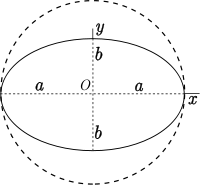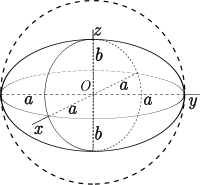Flattening
Flattening is a measure of the compression of a circle or sphere along a diameter to form an ellipse or an ellipsoid of revolution (spheroid) respectively. Other terms used are ellipticity, or oblateness. The usual notation for flattening is f and its definition in terms of the semi-axes of the resulting ellipse or ellipsoid is


The compression factor is b/a in each case. For the ellipse, this factor is also the aspect ratio of the ellipse.
There are two other variants of flattening (see below) and when it is necessary to avoid confusion the above flattening is called the first flattening. The following definitions may be found in standard texts[1][2][3] and online web texts[4][5]
Definitions of flattening
In the following, a is the larger dimension (e.g. semimajor axis), whereas b is the smaller (semiminor axis). All flattenings are zero for a circle (a = b).
(first) flattening Fundamental. Geodetic reference ellipsoids are specified by giving second flattening Rarely used. third flattening Used in geodetic calculations as a small expansion parameter.[6]
Identities involving flattening
The flattenings are related to other parameters of the ellipse. For example:
where is the eccentricity.
Numerical values for planets
For the WGS84 ellipsoid to model Earth, the defining values are[7]
- a (equatorial radius): 6 378 137.0 m
- 1/f (inverse flattening): 298.257 223 563
from which one derives
- b (polar radius): 6 356 752.3142 m,
so that the difference of the major and minor semi-axes is 21.385 km (13 mi). (This is only 0.335% of the major axis, so a representation of Earth on a computer screen would be sized as 300px by 299px. Because this would be virtually indistinguishable from a sphere shown as 300px by 300px, illustrations typically greatly exaggerate the flattening in cases where the image needs to represent Earth's oblateness.)
Other values in the Solar System are Jupiter, f = 1/16; Saturn, f = 1/10, the Moon f = 1/900. The flattening of the Sun is about 9×10−6.
Origin of flattening
In 1687, Isaac Newton published the Principia in which he included a proof that a rotating self-gravitating fluid body in equilibrium takes the form of an oblate ellipsoid of revolution (a spheroid).[8] The amount of flattening depends on the density and the balance of gravitational force and centrifugal force.
See also
References
- Maling, Derek Hylton (1992). Coordinate Systems and Map Projections (2nd ed.). Oxford; New York: Pergamon Press. ISBN 0-08-037233-3.
- Snyder, John P. (1987). Map Projections: A Working Manual. U.S. Geological Survey Professional Paper. 1395. Washington, D.C.: United States Government Printing Office.
- Torge, W. (2001). Geodesy (3rd edition). de Gruyter. ISBN 3-11-017072-8
- Osborne, P. (2008). The Mercator Projections Archived 2012-01-18 at the Wayback Machine Chapter 5.
- Rapp, Richard H. (1991). Geometric Geodesy, Part I. Dept. of Geodetic Science and Surveying, Ohio State Univ., Columbus, Ohio.
- F. W. Bessel, 1825, Uber die Berechnung der geographischen Langen und Breiten aus geodatischen Vermessungen, Astron.Nachr., 4(86), 241–254, doi:10.1002/asna.201011352, translated into English by C. F. F. Karney and R. E. Deakin as The calculation of longitude and latitude from geodesic measurements, Astron. Nachr. 331(8), 852–861 (2010), E-print arXiv:0908.1824, Bibcode: 1825AN......4..241B
- The WGS84 parameters are listed in the National Geospatial-Intelligence Agency publication TR8350.2 page 3-1.
- Isaac Newton:Principia Book III Proposition XIX Problem III, p. 407 in Andrew Motte translation